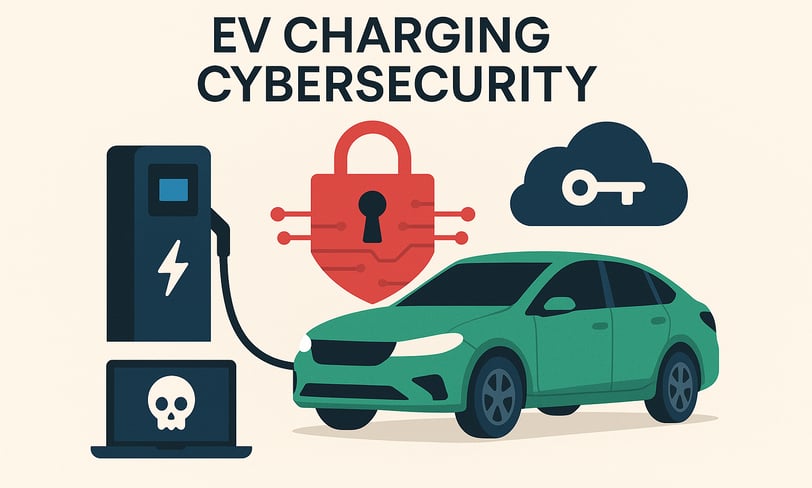Securing the Future: Cybersecurity Challenges and Solutions for EV Charging Infrastructure
As electric vehicle adoption rapidly grows, so do the cyber threats targeting the charging infrastructure. Insecure public chargers and vulnerable payment systems present significant dangers. Policymakers must act swiftly to establish cybersecurity standards and safeguard the future of electric mobility. The security of our charging networks directly impacts consumer trust and the widespread acceptance of EVs
Sumit Bhartiya
5/27/20253 min read


Introduction
The rapid adoption of Electric Vehicles (EVs) has ignited a revolution in the transportation and energy sectors. As cities expand their public charging infrastructure and consumers increasingly depend on smart home chargers, the cybersecurity landscape around EV charging grows increasingly complex. For policymakers, understanding the risks and formulating effective cybersecurity frameworks are essential to safeguard national infrastructure and public trust. In this blog, we delve into the potential vulnerabilities and the essential security measures necessary to protect EV charging systems from evolving cyber threats.
1. The Interconnected Landscape of EV Charging
EV charging infrastructure is a mosaic of interconnected components:
Electric Vehicles (EVs)
Charging stations (public and residential)
Mobile applications and user interfaces
Payment and billing systems
Cloud platforms and backend servers
Smart grid and Vehicle-to-Grid (V2G) integration
Each component opens new doors for potential exploitation if not properly secured. For policymakers, this underscores the need for holistic regulations and standards that address the full ecosystem.
2. Key Vulnerabilities in EV Charging Ecosystem
2.1 Public Charging Stations
Physical access allows attackers to tamper with ports, firmware, or insert malicious USB devices.
Many chargers still communicate over insecure protocols like HTTP.
Admin interfaces are often protected with default or weak passwords.
2.2 Mobile Apps and APIs
Mobile apps used to locate, reserve, and pay for charging can leak sensitive user data.
Insecure APIs can allow session hijacking, spoofed requests, and privilege escalation.
2.3 Backend Servers and Cloud Platforms
Improper access control can lead to unauthorized manipulation of billing, charging status, or user data.
Exposed admin panels are vulnerable to brute-force or injection attacks.
2.4 EV-to-Charger Communication
Spoofed communications in V2G scenarios could disrupt grid stability.
MITM attacks are possible without strong encryption and authentication.
2.5 Firmware and Software Vulnerabilities
Lack of secure OTA (Over-the-Air) update mechanisms exposes devices to persistent malware.
Hardcoded credentials and secrets within firmware can be reverse-engineered and exploited.
2.6 Payment System Exploits
Card skimming through compromised terminals.
API abuse for unauthorized billing or charging sessions.
2.7 Supply Chain Risks
Third-party components may include insecure code or backdoors.
Insecure firmware from manufacturers can be a hidden risk.
3. Strategic Security Measures for Policymakers
3.1 Develop and Enforce National Cybersecurity Standards
Mandate secure boot, firmware signing, and encrypted communication (TLS 1.3+) across all EVSE.
Require mutual authentication protocols between chargers, vehicles, and backend systems.
3.2 Regulatory Requirements for Identity and Access Management
Enforce the use of Multi-Factor Authentication (MFA) and Role-Based Access Control (RBAC) in EVSE platforms.
Standardize procedures for credential management and secure device onboarding.
3.3 Secure API and Software Practices
Require developers to adhere to secure software development lifecycle (SDLC) practices.
Establish guidelines for API authentication (OAuth2, JWT) and regular code audits.
3.4 Secure Firmware Updates and Supply Chain Vetting
Mandate digitally signed firmware with rollback prevention.
Vet third-party suppliers for cybersecurity compliance and track firmware lineage.
3.5 Payment Security Compliance
Enforce PCI DSS and other relevant financial standards across public and private EVSE networks.
Promote end-to-end encryption and tokenization in all payment transactions.
3.6 National Monitoring and Response Programs
Support the creation of a national SIEM network for real-time monitoring of EVSE threats.
Establish mandatory incident reporting for EVSE providers.
4. Real-World Incidents and Lessons for Governance
UK Incident (2022): Public chargers were hacked to display inappropriate content due to weak access controls. Highlighted the need for regulatory enforcement of UI and firmware standards.
Tesla Wall Connector Bug (2023): Misconfigured Wi-Fi allowed attackers to disable chargers or spoof billing data. Reinforced the importance of mandatory configuration hardening.
Security Research at Black Hat: Demonstrated DoS attacks on EVSE via connection flooding. Urged the need for government-mandated API rate limiting and anomaly detection systems.
5. Policy Recommendations: Securing the Future of EV Charging
To future-proof EV infrastructure, policymakers should:
Draft and enforce comprehensive EVSE cybersecurity legislation.
Collaborate with international bodies (e.g., ISO, IEC) to standardize EV security protocols.
Support public-private partnerships to develop security testing labs and red teaming exercises.
Fund research and workforce development programs for EV cybersecurity.
Introduce certification schemes for compliant EVSE devices.
Conclusion
The EV charging infrastructure is a cornerstone of tomorrow’s transportation ecosystem. Yet without rigorous cybersecurity frameworks, it remains a soft target for cyber threats that can disrupt transportation, economic stability, and public trust. Policymakers have a unique opportunity and responsibility to shape resilient, secure EV charging ecosystems through proactive legislation, public-private collaboration, and international standardization.
Electric mobility is the future. Let’s secure it together.
My Mantra
Shielding your business with precision-crafted cyber defense
Consulting
hello@sumitbhartiya.com
© 2025 Sumit Bhartiya. All rights reserved.
